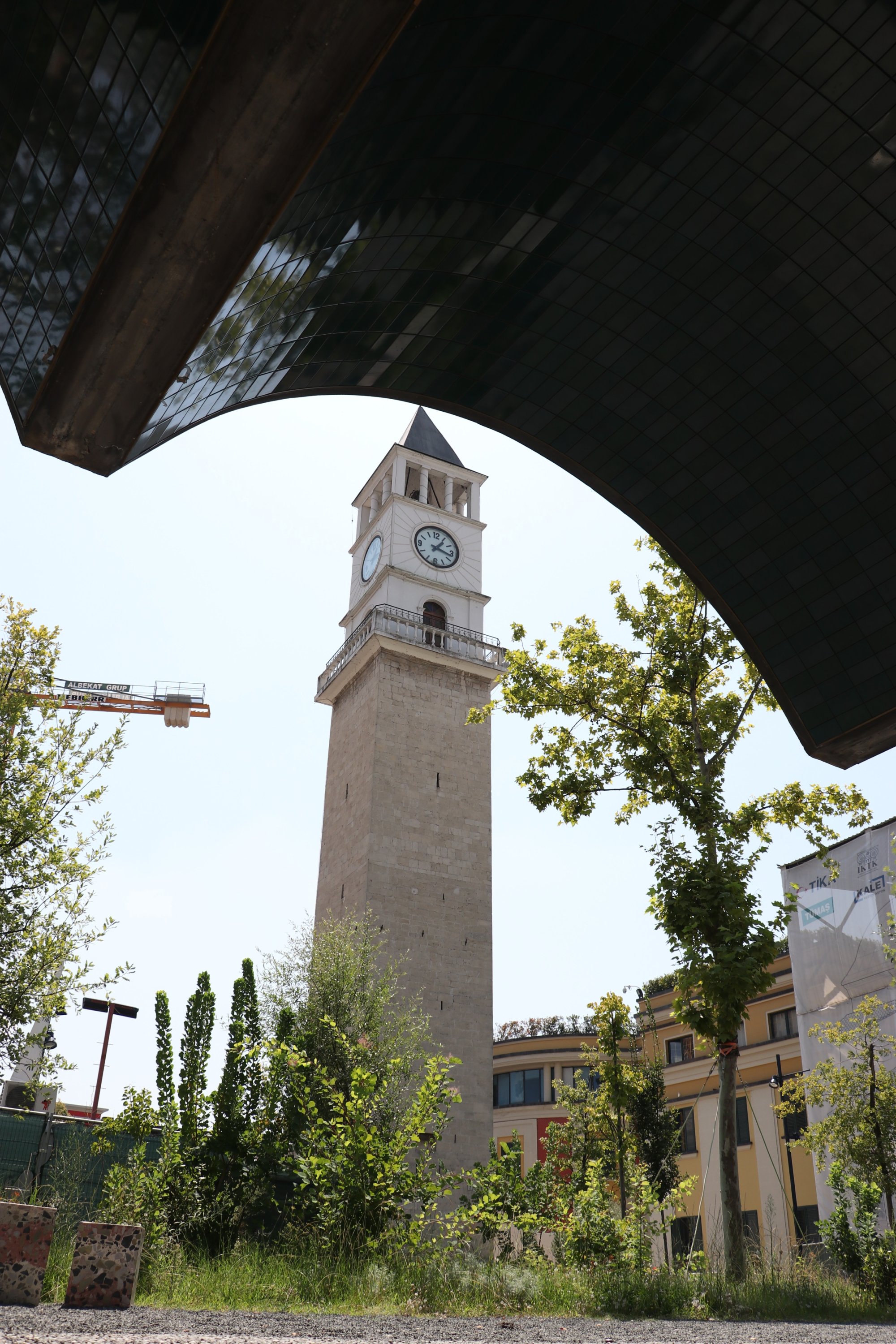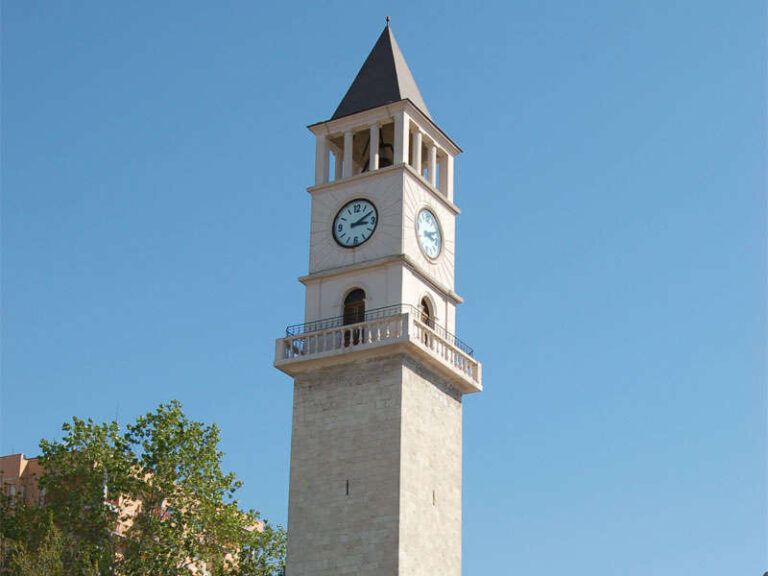
Key Takeaways
- The Clock Tower of Tirana is a symbol of the city’s rich history and cultural identity.
- Built between 1811 and 1812 by Haxhi Et’hem Bey, it served as a crucial timekeeping and spiritual reference point.
- Its architectural style blends Ottoman design with influences from Western and Romanesque trends.
- Throughout its history, the tower has experienced damages, renovations, and political changes, including modifications during the communist era.
- The tower remains a central landmark near Skanderbeg Square, offering visitors panoramic views and a glimpse into Tirana’s past.
Table of contents
- Historical Background: The Story of The Clock Tower of Tirana
- Architectural and Design Features: A Blend of Styles
- Cultural and Social Significance: Heart of Tirana
- Location and Visiting Information: At the Heart of Tirana
- Fun Facts and Anecdotes: Whispers Through Time
- Conclusion: A Living Testament
The Clock Tower of Tirana is more than just a historical structure—*it’s a living symbol of the city’s evolution*. From its humble beginnings in the Ottoman era to its status today as a focal point for visitors and locals alike, this tower captures the essence of Tirana’s identity.
When strolling through the bustling streets near Skanderbeg Square, the clock’s ticking provides a rhythmic backdrop to the city’s vibrant life. Its presence reminds us how history and culture intertwine in this Albanian capital.
Historical Background: The Story of The Clock Tower of Tirana
The origins of the Clock Tower of Tirana date back to the early 19th century, a period marked by Ottoman influence on Albanian architecture. Commissioned by Haxhi Et’hem Bey between 1811 and 1812, it was initially constructed to serve a practical purpose: indicating the time for the community and especially for the spiritual life centered around the nearby Et’hem Bey Mosque. *This utilitarian function was vital for the daily rhythm of Tirana’s residents.*
The clock mechanism was originally imported from Venice, renowned for its craftsmanship. Over the decades, technological updates—first from Germany and later Albanian-made mechanisms—kept the clock functioning amidst wear and tear. During World War II, the structure sustained significant damage in 1944. Following the war, renovations restored the tower, blending traditional Ottoman elements with newer architectural styles that reflected the changing political landscape of Albania.
For those interested in the Ottoman roots and architectural influences, resources such as JSTOR or Google Scholar offer valuable academic insights. Additionally, books available via WorldCat provide deeper context into Albanian history and Ottoman architecture.
Architectural and Design Features: A Blend of Styles
Rising approximately 35 meters (115 feet) above the ground, the Clock Tower exemplifies a mix of architectural influences. Made from stone and brick, it features Ottoman aesthetics with its slim, spiraling staircase winding around the interior walls. This staircase not only connects the various levels but also symbolizes the journey through Tirana’s history.
Originally designed with Ottoman motifs, the facade underwent a significant transformation after World War II. The reconstruction incorporated elements of Romanesque architecture, reflecting broader stylistic trends and material availabilities at that time. The clock mechanism itself evolved from its Venetian origins, being updated several times to incorporate new technology and reflect cultural shifts.
For detailed explorations of its architecture, books such as “Albanian Architecture” offer comprehensive insights. Journals and databases like SAGE Journals can further deepen understanding about construction techniques from that era.
Cultural and Social Significance: Heart of Tirana
The Clock Tower has historically been a gathering point—a symbol of Tirana’s communal life. Standing at the crossroads of social interaction and timekeeping, it embodied the heartbeat of the city’s daily routines. Its image appears in countless postcards, photographs, and tourism posters, reinforcing its status as an emblem of Tirana’s civic identity.
In contemporary times, the tower continues to host locals and visitors alike, serving as a meeting spot and an icon of cultural pride. Its story is woven into the city’s narrative, representing resilience and continuity through decades of change. The tower’s presence in media and promotional materials underscores its role as both a historical relic and a living part of Tirana’s urban fabric.
For cultural insights, browse Travel Blogs and Local Media for a contemporary perspective on its significance.
Location and Visiting Information: At the Heart of Tirana
The Clock Tower is conveniently located near landmarks like Skanderbeg Square and the Et’hem Bey Mosque. Its central position makes it easily accessible on foot, perfect for integrating into a walking tour of Tirana.
Entry to the tower is usually free, but visitors should check current opening hours and any potential restrictions with official sources such as Tirana Tourism. Climbing the spiral staircase rewards visitors with stunning panoramic views of the city—an ideal way to appreciate Tirana’s streets and skyline from above.
While in the vicinity, explore other sites like Skanderbeg Square, the National Historical Museum, and the Palace of Culture, each offering additional layers of Tirana’s history.
For recent updates, consult Google Maps or the Official Tirana Tourism Website.
Fun Facts and Anecdotes: Whispers Through Time
Interwoven with local lore, the tower holds many stories. During World War II, it sustained damage but remained resilient. Intriguingly, during the communist period, the clock face underwent a transformation—replacing the cross with a star, reflecting the shifting political landscape and ideological shifts within Albania.
Legend has it that Haxhi Et’hem Bey’s spirit still lingers around the tower, with some locals claiming to have seen flickering lights or heard whispers during quiet nights. These tales add a layer of mystique, inviting curiosity and speculation about the tower’s past inhabitants.
For more stories, explore Local Blogs and Oral Histories contributed by Tirana’s residents.
Conclusion: A Living Testament
The Clock Tower of Tirana stands tall as a testament to the city’s enduring legacy. It’s not just a place to check the time, but a *symbol of resilience, history, and cultural identity*. Visiting this iconic landmark offers a chance to connect with Tirana’s stories, appreciating how the past continuously shapes the present.
Whether you’re admiring panoramic views from the top, marveling at the architecture, or simply soaking in the atmosphere, the tower invites exploration and reflection. It’s a reminder that history is not just preserved in books, but is alive in the heart of the city.
We encourage everyone to pay a visit, delve into its stories, and carry forward the legacy of Tirana’s most iconic monument. The Clock Tower waits as a symbol of time, history, and the spirit of Albania.


0 Comment